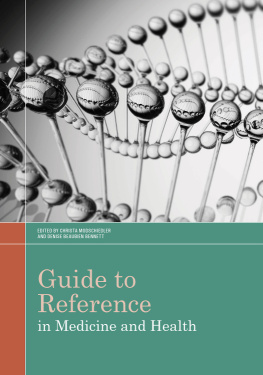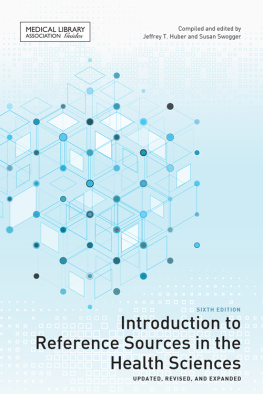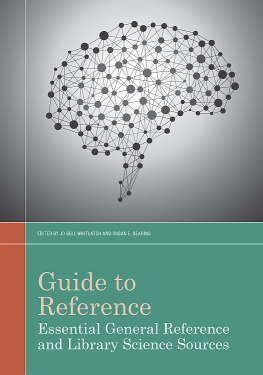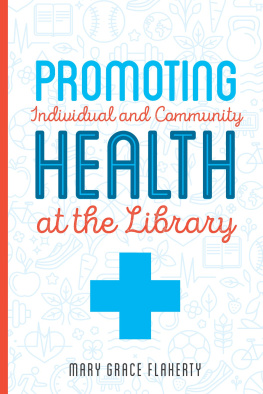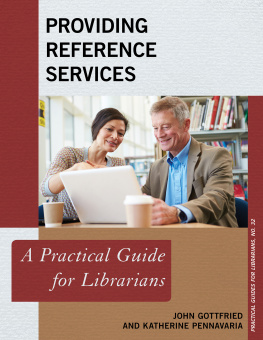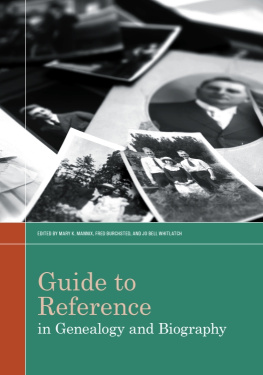
GUIDE TO REFERENCE IN MEDICINE AND HEALTH
ALA Editions purchases fund advocacy, awareness, and accreditation programs for library professionals worldwide.
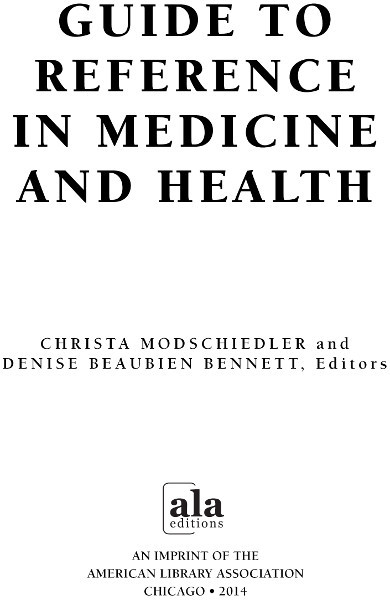
2014 by the American Library Association
Extensive effort has gone into ensuring the reliability of the information in this book; however, the publisher makes no warranty, express or implied, with respect to the material contained herein.
ISBNs: 978-0-8389-1221-8 (paper); 978-0-8389-1982-8 (PDF); 978-0-8389-1983-5 (ePub); 978-0-8389-1984-2 (Kindle). For more information on digital formats, visit the ALA Store at alastore.ala.org and select eEditions.
Library of Congress Cataloging in Publication Control Number: 014005002.
Cover design by Alejandra Diaz. Image jongjet303 / Shutterstock, Inc.
CONTENTS
The American Library Association has long been a source for authoritative bibliographies of the reference literature for practicing librarians, library educators, and reference service trainers. ALAs Guide to Reference Books was printed in eleven editions over nearly a century, and was succeeded in 2009 by the online Guide to Reference (www.guidetoreference.org). The Guide to Reference segments, drawn from the online Guide, continue that tradition with expertly compiled, discipline-specific, annotated bibliographies of reference works and serve as snapshots of the evolving content of the Guide.
Although intended for use largely in North American libraries serving institutions of higher education, the segments will also be valuable to public and school librarians, independent researchers, publishers and book dealers, as well as librarians outside North America, for tasks such as identifying sources that will answer questions, directing researchers, creating local instructional materials, educating and training LIS students and reference staff, and inventorying and developing reference collections. These guides provide a usably comprehensive, rather than exhaustive, repertory of sources as the foundation for reference and information services in todays higher education settings. They include works that can most usefully satisfy the vast majority of demands made on a reference service, while not altogether excluding exotic or little-known works that will meet only the unusual need.
In addition to providing classified annotated bibliographies, topical sections include editors guides that orient readers to each discipline, its scope and concerns, and the types of sources commonly consulted. The editors guides will be useful to the generalist librarian and to the LIS student as background to the bibliographies or as intellectual frameworks for addressing reference questions.
The reader will find entries for works that are, for the most part, broadly focused; works on individual persons or with a narrow geographical or chronological focus are generally not included. Selection criteria favored titles published in the last twenty years; the reader may consult earlier printed bibliographies and indexes, such as the numerous print editions of the Guide to Reference Books, for many earlier and still important works. As libraries shift their print reference works to the general stacks or to remote locations, the online Guide and its older print editions may help to identify reference works that are no longer close at hand.
Sources in the Guide include websites, search engines, and full-text databases as well as the traditional array of encyclopedic, bibliographic, and compendious works. Online sources have replaced their printed versions for most librarians under most circumstances. A source only appears in one format; its annotation will identify the format options and describe the relationships between online and print versions. New reference works or editions are not automatically included in the Guide. Selection criteria favor sources that have stood some test of time and utility, as well as sources that are free but authoritative or sources that require purchase or licensing but are held at enough libraries to be reasonably available to readers of the Guide. The topical sections do not include universal sources that are covered in the General Reference Works division such as Wikipedia or Ulrichs Periodicals Directory; please consult the Essential General Reference volume or the online Guide for general sources that are common to all disciplines.
The reader is encouraged to peruse the annotations of entries in the same subcategory as known items. An annotation may contain extensive cross references to related sources that are not described separately as well as comparisons to related sources, indications of appropriate audiences for the source, and other details that provide significant added value. In an attempt to balance inclusion and exhaustion, a source may be included in several but not necessarily all relevant subcategories.
This segment on Medicine and Health includes sources for each patron in every type of library. The subsection on Consumer Health is rapidly growing and provides guidance to authoritative sources, which may be the aspect for which most patrons request assistance. The Division Editors choice for most entertaining subsection is Medical illustration and images in the Medicine category, where records lead to atlases, photos, drawings, videos, reusable images and more, potentially matching every level of patron need from consumer to student to researcher.
We on the Guide to Reference team hope you find the segments helpful, and we welcome your comments at for details on subscribing or volunteering to participate in the continuing development of the Guide to Reference.
Denise Beaubien Bennett
General Editor, Guide to Reference
Division Editor for Science, Technology, and Medicine
Christa Modschiedler, retired Biomedical Librarian from the University of Chicago, has served as the Contributing Editor for the Medical and Health Sciences section of the Guide to Reference since the 11th print edition (1996). Denise Beaubien Bennett, Engineering Librarian at the University of Florida, is the Division Editor for the Science, Technology, and Medicine sections since 2005 and also has served as the General Editor of the Guide to Reference since 2009.
The Medicine and Health category provides an annotated list of print and electronic biomedical and health-related reference sources, including Internet resources and digital image collections. The original purpose of the Guide to Reference remains (i.e., to provide a wide selection of bibliographic and information resources relevant to the provision of reference services in a biomedical library). It is intended to help users find relevant research, clinical, and consumer health information resources. As with previous editions of the Guide, the current edition cannot claim to be exhaustive in coverage; coverage in the medical section/subsections remains rather selective. Following previous editions of the Guide, some of the resources in this section are not strictly reference materials in the traditional sense. Emphasis is on U.S. resources, with a few representative examples from other countries. With few exceptions, materials in the medicine section would generally be found in the Library of Congress classification R. The intended audience is biomedical researchers, clinicians, and allied health professionals, as well as health consumers and the general public.
Next page
